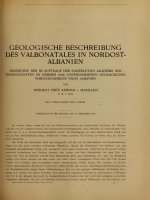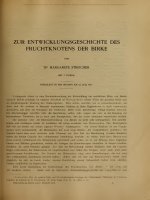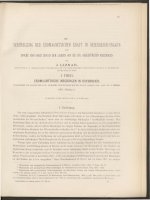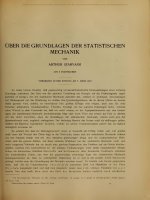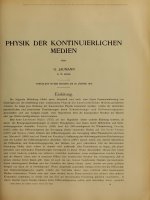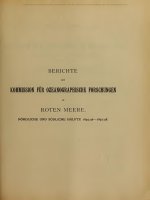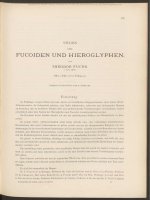Akademie D Wissenschaften Wien, Anzeiger Vol 133-2-0033-0045
Bạn đang xem bản rút gọn của tài liệu. Xem và tải ngay bản đầy đủ của tài liệu tại đây (877.48 KB, 13 trang )
©Akademie d. Wissenschaften Wien; download unter www.biologiezentrum.at
A n z eig er
Anzeiger Abt. II (1996) 133: 33—45
Mathematisch-naturwissenschaftliche Klasse Abt. II
Mathematische, Physikalische und Technische Wissenschaften
© Österreichische Akademie der Wissenschaften 1997
Printed in Austria
On Optimal Liftings of Sequences*
Von
P. Zinterhof
Edmund Hlawka %um achtzigsten Geburtstag gewidmet
(Vorgelegt in der Sitzung der math.-nat. Klasse am 12. Dezember 1996
durch das w. M. August Florian)
1. Setting of the Problem
From the early work of Hlawka and Korobow on it became clear that
many problems of high dimensional numerics are to be solved using
number theoretical methods. NTN (Number Theoretical Numerics)
provides best possible methods for simulation, numerical integration,
approximation and interpolation, integral equations and many other
problems in the multivariate domain, where uniform distribution of
sequences or multivariate integration plays the key role (approximation of
functions e.g. is mostly based on convolution). For a review see for
example [1], [4], [5], [2], [9]. Recently NTN plays a role in image
processing too [21] and [23]. It is considered as an important problem to
construct sequences in the s-dimensional unit cube Gs —[0,iy having
good properties from the simulation or numerical integration point of
view. It means essentially the quality of uniform distribution of the
sequences to be used. The quality of distribution of sequences can be
measured by means of different concepts, of which the most commonly
used are the Discrepancy D * and the Diaphony FNof the sequence Xq,
*This paper has been presented at the workshop Parallel Numerics 96/Go^d Martuljek,
Slovenia/September 11—13, 1996. The results are part of the results of the international
PACT-Project, supported by the „Bundesministerium für Wissenschaft, Verkehr und
Kunst“.
34
©Akademie d. WissenschaftenP.Wien;
download unter www.biologiezentrum.at
Zinterhof
*15 • • •5i^v-i ^ Gs — [0 , 1 ] . D Nand F n are knowingly defined by
T V -1
D%(wN) = SUp
t; Z
1V k=0
0 <7/< 1
|
FNM
=
y,
(1)
N
Z H2(Xk ~ xi) —\
(2)
iV 4/=l
where
^ (*) = Z , - 1
(3)
w eZ ’ ( ^ 1
is the s-variate normed Bernoulli-Polynomial modulo 1,
s
^ M
/
^ 2
= n ( l - 7
ft2
\
+ Y (l-2 x -/ )U
(4)
^ = max(l,|/%?|), w e Z , x = (xl5.. . , x , ) , x (eR. For properties and use of
the Diaphony see [15], [9], [25]. The typical order of magnitude of D *rand
F n of good sequences x0, x , , . . . , xN_ t GGs is
ln^AA
D % «— ,
]nh N
F n = ~ n ~'
„ „
A,ft>0.
(5)
As usual a
b means the existence of a positive number c such that
\a\ ^ cb.
Recently the Salzburg research groups of Hellekalek and Larcher and
the Vienna group of Prof. Niederreiter received best possible results with
respect to the estimation of
FN and the integration error and for
Quasi-Monte Carlo methods.
In many cases of application of high dimensional integration or
simulation a more complicated problem is posed. It consists in the
simplest case of the following problem:
Given numbers x 0 , . . . , xN_xEGx = [0,1), one has to construct a set of
points xk = ( x Xky. . . , xsk) e G s = [0,1)', ^ = 0 , . . . , N —1 with good dist
ribution properties, such that all the x /ifee { x 0, ... , x ^ ^ }, i = 1,... ,s,
k = 0 . , N —1. It follows from the definition of Discrepancy D%, that
the Discrepancy of such a sequence xk,k = 0 , . . . , N —1, in general
cannot be less than the Discrepancy of the original x 0 , . . . , xN_ , E Gx. So
the problem consists of optimal Lifting of the sequence x 0, . . . , xN_ , e Gx
to Gs = [0,1)' In the theory of optimal experiments the problem is well
known too. So this paper is also a contribution to the theory of uniform
designs.
©Akademie d. On
Wissenschaften
download
www.biologiezentrum.at
OptimalWien;
Liftings
ofunter
Sequences
35
2. Solutions of the Lifting Problem
Let r jv= {0,1,... , N —1} and let for j = \ , . .. , s be given the finite
sequences Wj = Wj(N) = (x0 ■, x2j■,...,xN_ t ■)G[0,1) N The sequences
«'have discrepancies D% (wj) = D % j J = 1 , . . . , j. Let Q = I !,'=j Wjsuch
that Q consists of all points x = ( x ( k u 1 ) , x( k2, 2 ) , . . . , x ( k s,s)), where
x (kj J ) , = xkj,p
(ku . . . , k s) e T sN.
Let
(S’ = [0,1)'
and
pj ^(x1, . . . , xs) = x - , j = 1, . . . , s, be the projection of Gs onto [0,1). We
give the following
Definition 1. Thefunction L : (w x, . . . , ws) —*■Q such that
a)
L( w x, , ws) = {y i 2, . . . , J N} —W( N) is a sequence o f N points in
Gs and such that
b) p j { L ( w , , . . . , w s)) = {xy , . . . yxNJ) f o r > = l , . . . , j .
is called a Lifting o f the one-dimensional sequences wu . .. ,w s to Gs. The Lifting
L will be called regular i f
b*) pj (L (wx, . . . , ws)) = Pj( wj) , where Pj is a permutation o f Wj (and o f GN)
depending on j and L itself.
We will prove now the following
Theorem 1. Let a= (ax, . . . , ss) E U and (aj, N ) = 1 fo r j = 1, . . . , s. Let
furthermore D%(a) be the Discrepantry o f the sequence ka/N, k = 0 , . . . , N —1
and consider the regular lifting La induced by a
.LaO i , . . . , ws ) ={ x ( a k ) , k =
(6)
such thatx(ak) = (x(axk, 1), x(a2ky2), ... , x ( a sk, s) ) , k = 0, . . . ,7V—1, (we
take the indexes afe mod TV o f course), than the Discrepancy D * (w (a) ) can be
estimated by
s
max D* ( wj ) < D * ( w ( a ) ) «
£ D%(Wj) + D%(a)
J='[....x
(7)
y=l
Proof: Without loss of generality we assume the Wj , j —l , . . . , x , being
ordered:
0 < x0J < xx>y. <
< x A/_l y < l .
Let
y = (y„ . . . , ys),
0 < y j < 1 , 7 = 1 , . . . , j and let I{y) = (x :0
fl
xE l(y)
z fe ) = { o
-J S
)
(8)
and let for x = (x(/fe1, l ) , ... , x( ks, s)) gQ the function Ij/ be defined by
1 if
xE l(y)
©Akademie d. WissenschaftenP.Wien;
download unter www.biologiezentrum.at
Zinterhof
36
such that \jj(kx, . . . , ks) —%(x(/^1, l ) , . . . , x(ks,s)). According to the assu
med ordering of the points of »a, there are unique integers
rijyO < n < N —1, such that x„.j < and^ x)lj +x- > y j , j = 1, ... ,x. So
we get for the Fourier-transform of i/f:
^*■{0,1 }
I AK, ) =^i k,=0
E
+"A,/,V,
t
k, =0
(10)
where the dual group of G N
S is represented by
Mx
r 'v=
(11)
withMx= ( N —l)/2 for N = 1(2), Mx - N/2 - 1 for N = 0(2), M2 = M x
for i V=l ( 2) , M2 = Mx-\-\, Af=0(2). For mj = 0 we have with
m = max(l,|^?|)
2nimjkj/N
(12)
For nij # 0 is because of (11) ^ ^ 0 ( A/) and henceforth, with the notation
« x »
= min { | x —^ | ,^ e Z },
g2 n i mj(nj + 1)/N __^
I
9—Inimjkj/N
e 2nimj/N
kj —0
<
1
1
1N
<
< ----- .
s' m(nmj /N) 2 « 7i mj/ N »
2
(13)
So, for ( mx, . . . , ms ) e Y sN, holds the estimation
n
s X
t ‘
■
2 nimjkj/N
j — \ kj —0
<
1 /riV
1
1 I — = —----- —
N s j =l mj mx. . . m s
(14)
.
The technicality (14) is frequently used and well known. A direct
inspection of (10) shows
(15)
j-i
N
For the ,L,-lifted sequence w( a) , (6), holds with respect to (8), (9)
N -
1
/V — 1
A : = A ( w ( a ) e I ( y ) ) : = £ Xy (x(ak)) = £ ^ ( a 1k , . .. ,ask). (16)
k —0
©Akademie d.On
Wissenschaften
download
www.biologiezentrum.at
OptimalWien;
Liftings
of unter
Sequences
37
The counting function^ jumps in our case of the sequence x(ak) = a k/N,
k = 0 , . . . , N —l , aß Z', only at the points y = (n1 + \, n2 + 1, . . . ,
ns + V)/N such that one gets immediately
A
N
(»j + 1)... (ns +1)
Ns
(17)
Using e.g. the s-variate Taylor-formula of order one we get in a straight
forward manner
k=\
Combining (17) and (18) we get the right hand side part of (7)
S
D * ^ ( a ) ) < D % + £ ( f l fl +DN.k))D*N.ij= 1 k*j
k= 1
The left hand side part of (7) follows readily: Let e > 0 and
(W)
(20)
By the definition of Discrepancy there is an interval [0, y j 0(e)) =
such that
(21)
Let now
Is = T x T. .. x T x Ij0(£) x T x
x T,
(22)
then we have
(23)
The proof of Theorem 1 is complete.
There is a vast literature on the estimation of D%(a) if the a are good
lattice points or optimal coefficients (e.g. [9]). One observes that instead
of the cyclic Liftings k ^ a k mod ./Vone can use e.g. (t,m,s)-nets to lift
sequences as well. For the definition and properties of (t,m,s)-nets see [9].
Some latest results can be found in [6]. This observation leads to the
definition of Discrepancy of a Lifting:
38
©Akademie d. WissenschaftenP.
Wien;
download unter www.biologiezentrum.at
Zinterhof
Definition 2. Let L\ GN—>G SN, L(k) = a ( k ) e G SN, be a L ifting. We call the
Discrepanty o f the sequence a (k) /TV, k = 0 , . . . , N —1, mod 1, the Discrepanty o f
the Lifting L:
D%( L) = D % ( ^ , k = 0 , . . . , N - A
(24)
Analogously the Diaphony FN( L) o f the Lifting L is defined by
2
1 £ £
( a(k) —a( l ) \
Clearly, D * ( L) and FN(L) describe the mixing properties of the Lifting
L. The following more general theorems holds:
Theorem 2. I f L : GN—>G\v is a regular Lifting, then
max D% ( w ) < D * ( L ( w 1 , . . . , w s) ) < D%(L)
j = 1,
.,s
+ E (n (i+ ^ ))^ L
y=l k*j
k~1
(2Q
holds.
We will not carry out the proof which is similar to the proof of the
previous theorem.
3.
Some Com putational Aspects
In the case of application of the Lifting method one is interested in easy
and fast computation of the quality of the lifted sequences and furthermore
in the quality of the lift itself. According to Theorem 1 and (7) the
problem consists of a fast computation or effective estimation of D %{Wj),
j = 1, . . . , jand o iD * r(a) respectively. The computation of the Discrepan
cy of the one-dimensional sequences Wj, j = 1, . . . , s is readily performed
by means of the formula [5]
1
2£ + l
(27)
) —— + max
JJ 2N ' k = o , . . . , N
The computation or even the fast and effective estimation of D* ( a )
causes more problems. The following remarks, all based on known results
or techniques respectively, could be helpful in various situations of
applications of NTN to applied problems. From (14), (15), (17) it is clear
that for the cyclic Lifting L(a), aeZ ; 5 holds (SN(g) = 0 if g ^ O (N ),
D
©Akademie d.On
Wissenschaften
download
www.biologiezentrum.at
OptimalWien;
Liftings
of unter
Sequences
39
0N(g) = 1 otherwise)
D*(ä)<
5,2
I
8N(am)
(28)
Since Bakhvalov and Korobov [4] the minimal value q = q{a) of nontrivial
with <5N(a m) = 0 plays a key role in the theory of good lattice points
(cf. e.g. [9], p. 109) gave the effective estimation of D*j(a) using (28):
D * a < c }------(29)
q
An effective lower bound for q = q(a) is provided by the Diaphony of
ka/N,k=0,...,N-\-.
2
'V
/ka\
V-,b K1(am)
x 7 mx. . . m s > q n t h
which leads immediately to the effective estimation
*
D* r( a ) < c sFN( a ) - ( \ n N y
(3o)
(31)
Because of the symmetry properties of H 2(x) the computation of the right
hand side of (31) is performed in N/2 steps. We propose now an other
estimator for D*^a) which is based on techniques used by Korobov ([4])
to prove optimality conditions for integer vectors a.
Theorem 3. Let N e N, a = (au . .., as) e Z", (a;t N ) = 1 fo r i = 1, . . . ,
s then
N- 1
a.* k
1 —2 In 2sin7C----N
iVfc=l
- 1 + R N(a),
1 —2 In ^2 sin n ~p^J
(32)
with
(3+ 2 InN Y
\RN( a) \<( s + l)±----- j j - ! - .
(33)
Proof: The following Lemma is well known and easy to prove.
Lemma 1.
N —1
a) 1 -21n(2sin7ix) =
2nimx
Y
m = - ( N - 1)
Q
+ ------------ , |0|<1
m
N
«
X »
(34)
©Akademie d. WissenschaftenP.Wien;
download unter www.biologiezentrum.at
Zinterhof
40
b) For u = v'■+ r , j = 1, . . . , s holds
(35)
Y l uj = Y l ( vj + rj ) = Y\ vj + E
y=l
j= 1
j= 1
j = 1 \ k— \
k
with some \3 |< 1.
Let now
, /2 sin 7t—
• aik
U: = 1 —2 In
•>
V
N r
N —1
=
(36)
^I n i mj a j kj N
E
®7=—(A?—i)
mj
Vj N « a-k/N »
, |0|<
1,
j.
We have
(37)
Uj \< 1 + 2 |ln|^2 sin^ ) | <1 + 2 InA/,
r\ < ------------------- = 1.
7 —N « 1 / N »
Consequently holds for
AA—1
a,k
2 sin n—
(
/
a tk
1 —2 In 2sin7C---- ]/
,
V
TV
iv- i
.
^2ti/(«7,m, + +<7Xwj.)k/n
E-(N- 1) -------------- +Ö»-
.
Ig l l
\<< a]k / N »
|
(38)
n
(2 4- 2 InAT)J_ 1
Af
l^sl
^
'‘ ’ « ä, k / N » J '
Obviously holds
(39)
©Akademie d.On
Wissenschaften
download
www.biologiezentrum.at
OptimalWien;
Liftings
of unter
Sequences
41
such that we get
N- 1
£ [1 - 2 \ n ( 2 s i n n a xk / N ) ] . . . [ l - 2 In (2 sin n ask/N)]
k=l
N - 1
y
(40)
+ . . . ^ ^ ) — 1 _|_(^ + 21nA/y 1
ms =—(iV—l)
m x. . . m s
N
N
y 0 (
gi
,
Os
j ^ x ° \ « Ö, k / N »
" ' « ask/N »
_ N _|_n
^
<3^(#t ^
mx,...,ms=-(/V-l)
mx. . . m s
(2 + 2 In A/')s - 1 TV—
y 1
A7A=i
\ « a k/ N »
mx,...,ms=
1
• - ms
« a k/ N »
Using
7V-1
I
^ - ^ < ( 3 + 21nA/y,
(41)
, ..., wj. = - (/V- \)m \- • - m s
N—1
we get finally
&N(a\m\~l~• ■•~l~^j^j) _ 1 V~'
,Wj= - ( y v - i)
mx. . . ms
N k= i
y
1 —21n^2 sin7T-^r
+
(
a,k
2sin7r— ,
ivyj
(42)
,
where
\*N\<
(43)
^
(3 + 2 In iV )1
^
(2 + 21n A/y-1
,,
(3 + 21niVV
^
--------(1 +lnA/) < -------- ^------- (j + 1).
42
©Akademie d. WissenschaftenP.Wien;
download unter www.biologiezentrum.at
Zinterhof
Because of the well known inequality (confer in this paper (28))
D%{a) <
///j,...,
5hl(a,m, +
+ arm,)
£
NK ' '=----- = ' ‘I
ft/s —{N—1)
(44)
—
the proof of the theorem is now complete.
Rem ark. Despite the fact that for certain N, s essentially best possible
lattice points a = ( ax, . . . ,as) and corresponding estimations of D%(a)
are known, the above theorem is useful, because it is not always possible
to use (or even to find) the best possible lattice points. Frequently one has
to use some Lifting La, where the a comes from any where. The
complexity of the right hand side of (44) is N 1, whereas the complexity of
the right hand side of (42) is only N/2.
Peter Zinterhof jun. wrote an efficient C-code for cyclic liftings
according to [6]. It works extremely fast on shared memory machines
using the software PVM (Parallel Virtual Maschine).
Zinterhof jun. made also a series of experiments. We now give some
numerical results as examples. Because of the high computational compl
exity of Discrepancy in higher dimensions we use only the Diaphony as
estimator. Confer however (31), (32). For the convenience of notation let
-1 N - 1
j axk\
>inn <---->
-1
1 —21n( 2 sin71
In — - E 1 —2 In ( 2 sin
N
\N$
(45)
We call the expression /N(x0, . . . , xN_x) the Logophony of the finite
sequence x0, . . . , xjY_ ,. It will be studied more extensively in a forthco
ming paper.
We mention in this paper only some results in the two-dimensional
case. In this case we use the fact that cyclic liftings based on number
theoretic properties of the Fibonacci-sequence are a very good choice. So
we call those Liftings Fibonacci-Liftings. We will use the classical
Fibonacci-sequence 1,1, 2, 3, 5,. .. , f t =f „_x+ /,_2>__ F°r the Fibonac
ci-Lifting as we call it choose N = f „ ax= \,a2 —f„_v Uniform distribu
tion properties of the triplets (iV, 1, a^) are apparently described the first
time in [4]. See also Niederreiter [9]. We will give now two simple
numerical examples
a) Lifting the sequence k/N, k = \ , . . . , N h y the two-dimensional
Fibonacci-Lifting. Let Fxbe the Diaphony of the sequence k/N itself and
let F2 be the Diaphony and lN the Logophony respectively of the
two-dimensional lifted sequence. Confer (45) we give the following small
©Akademie d.On
Wissenschaften
download
www.biologiezentrum.at
OptimalWien;
Liftings
of unter
Sequences
43
table of results:
N, a2
F,
f2
13,8
55,34
377,233
610,377
987,610
1597,987
2584,1597
4181,2584
6765,4181
10946,6765
1.3952 e-2
3.2978 e-2
4.8111e-3
2.9734e-3
1.8376e-3
1.1357e-3
7.0193e-4
4.3381e-4
2.681 Oe-4
1.6567e-4
6.8982e-l
1.9531e-l
3.3745e-2
2.1591e-2
1.3783e-2
8.7822e-3
5.5856e-3
3.5470e-3
2.2493e-3
1.4246e-3
1.0385
5.8417e-l
1.8560e-l
1.3401e-l
9.5693e-2
6.7675e-3
4.7457e-3
3.3033e-3
2.2841 e-3
1.5699e-3
b) Lifting the sequence {ke}, k = 1, . . . , iV, e = 2,7\
This classical
Kronecker-Sequence has knowingly very good uniform distribution
properties. Nevertheless, because the sequence is infinite, by a famous
result due to W. Schmid the D * >
for infinitely many values of
N (confer for example [9]). In the following small table Fx means the
Diaphony of the sequence {ke}, k = 1, . . . , N whereas F2is the Diaphony
of the two-dimensional lifted sequence using the corresponding Fibonacci-Lifting.
N
Fx
f2
13
55
6765
10946
2.4019e-l
6.6385e-2
8.2206e-4
4.4429e-4
7.3767e-l
2.1115e-l
2.5034e-3
1.5392e-3
It is a consequence of our first theorem, that in example a) the values of F2
give the exact quality of the Fibonacci-Lifting in terms of the Diaphony of
the Lifting. For the values l2holds the same, they are independent of the
lifted sequences. The same situation occurs in arbitrary dimensions s\
Lifting the sequence k/N, k = 1, . . . , N, the resulting Discrepancy D*,
the Diaphony FNand lNas well give all numerical evidence of the quality
of the Lifting which is used.
44
©Akademie d. WissenschaftenP.Wien;
download unter www.biologiezentrum.at
Zinterhof
References
[1] Hlawka, E.: Theorie der Gleichverteilung. Bibliographisches Institut, 1979.
[2] Hlawka, E., Firneis, F., Zinterhof, P.: Zahlentheoretische Methoden in der Numeri
schen Mathematik. Oldenbourg, 1981.
[3] Keng, H.L., Yuan, W.: Applications of Number Theory to Numerical Analysis.
Springer-Verlag, 1981.
[4] Korobov, N.M.: Number-Theoretic Methods in Approximate Analysis. Fizmatgiz,
1963 (in Russian).
[5] Kuipers, L., Niederreiter, H.: Uniform Distribution of Sequences. J. Wiley & Sons,
1974.
[6] Larcher, G., Lauß, A., Niederreiter, H., Ch. Schmid, W.: Optimal polynomials for
(t,m,s)-nets and numerical integration of multivariate Walsh series. SIAM J. Numer.
Analysis, 1995.
[7] Larcher, G., Niederreiter, H., Ch. Schmid, W.: Digital nets and sequences construc
ted over finite rings and their application to quasi-Monte Carlo integration. Techni
cal report, Monatsh. Math., 1995.
[8] Lauß, A., Zinterhof, P., Feldbacher, M.: Parallel Implementation of Fast Algorithms
for good Lattice Points. Technical Report D5Z-la, PACT Project, April 1994.
[9] Niederreiter, H.: Random Number Generation and Quasi-Monte Carlo Methods.
SIAM, Philadelphia, 1992.
[10] Niederreiter, H.: New developments in uniform pseudorandom number and vector
generation. In: Niederreiter, H., Shiue, P.J.-S.: (eds.) Monte Carlo and Quasi-Monte
Carlo Methods in Scientific Computing. Lecture Notes in Statistics, volume 106.
Springer-Verlag, 1995.
[11] Salchegger, M., PaNIntE: A New Environment for Solving s-dimensional Integral
Equations of the Convolution Type by Parallel Number Theoretical Numerics.
Technical Report R5Z-2, PACT Project, October 1994.
[12] Salchegger, M.: Parallel number theoretical numerics for solving s-dimensional
integral equations of the convolution type. In: Vajtersic, M., Zinterhof, P.: (eds.)
Proceedings of the International Workshop Parallel Numerics ’94, pp. 15—23,
September 1994.
[13] Salchegger, M.: New Parallel Numerics for Hydro Unit Calculation. In: Vajtersic, M.,
De Pietro, G., Giordano, A., Zinterhof, P.: (eds.) Proceedings of the International
Workshop Parallel Numerics ’95, pp. 67—83, September 1995.
[14] Wegenkittl, S.: On empirical testing of pseudorandom number generators. In:
Vajtersic, M., De Pietro, G., Giordano, A., Zinterhof, P.: (eds.) Proceedings of the
International Woorkshop Parallel Numerics ’95, September 1995.
[15] Zinterhof, P.: Uber einige Abschätzungen bei der Approximation von Funktionen
mit Gleichverteilungsmethoden. Technical Report 185, Sitzungsbericht Österr.
Akad. d. Wissensch., Math.-Naturwissensch Kl. II, 1976.
[16] Zinterhof, P.: On Parallel Methods in Number Theoretical Numerics. Technical
Report R5Z-5, PACT Project, October 1994.
[17] Zinterhof, P.: Parallel Generation and Evaluation of Weyl Sequences. Technical
Report R5Z-4, PACT Project, October 1994.
[18] Zinterhof, P.: Progress in the NEWTON Project. In: Vajtersic, M., Zinterhof, P.:
(eds.) Proceedings of the International Workshop Parallel Numerics ’94, pp. 1—14,
September 1994.
©Akademie
d. Wissenschaften
Wien; download
unter www.biologiezentrum.at
P. Zinterhof:
On Optimal
Liftings
of Sequences
45
[19] Zinterhof, P.: Fast Adaptive Methods for Image Compression: Parallelizable
Algorithms for Haar Tesselations. Technical Report R5Z-6, PACT Project, March
1995.
[20] Zinterhof, P.: Some new Results in High Dimensional Approximation of Functions
(Algorithms and Implementations on Parallel Computers). In: Kuwait Foundation
for the Advancement of Science (KFAS) Kuwait University, Department of
Mathematics & Computer Science, editor, Proceedings of the International Work
shop on the Recent Advances in Applied Mathematics (RAAM’96), pp. 541—554,
May 1996.
[21] Zinterhof, P., Zinterhof, Jun., P.: Hyperbolic Filtering of Walsh Series. Technical
Report 03/93, Research Institute for Software Technology, March 1993.
RIST + +
[22] Zinterhof, P., Zinterhof Jun, P.: Searching for good lattice points in parallel.
Technical Report D 5Z-lb, PACT Project, May 1994.
[23] Zinterhof, P., Zinterhof Jun, P.: Local Karhunen-Loeve Bases and their Parallel
Computation. In: Vajtersic, M., DePietro, G., Giordano, A., Zinterhof, P.: (eds.)
Proceedings of the International Workshop Parallel Numerics ’95, pp. 125-142,
September 1995.
[24] Zinterhof, P., Schmitzberger, P.: Integrate: A Kernel of FORTRAN and C package
PANNUM for High Dimensional Numbertheoretic Quadrature. Technical Report
ACPC/TR 93-17, Austrian Center of Parallel Computing, 1993.
[25] Zinterhof, P., Stegbuchner, H.: Trigonometrische Approximation mit Gleichvertei
lungsmethoden. Studia Scientarium Mathematicarum Hungarica, 13: 273-289,
1978.
Anschrift des Verfassers: Prof. Dr. Peter Zinterhof, Institut für Mathematik, Hellbrun
nerstraße 34, A-5020 Salzburg.

